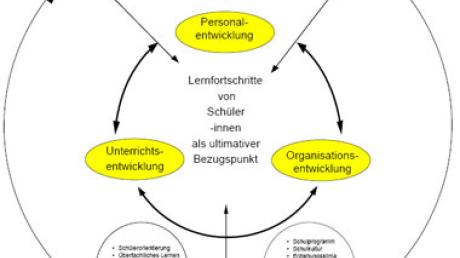School development begins when changes are initiated at the instructional level. School development does not yet begin when teachers undergo further training and develop new competencies and methodological confidence. The skills and ideas gained must be "reflected" in learning and teaching arrangements derived from them in the classroom. If implemented successfully, this legitimizes the change in framework conditions.

Directions 1:
First the staff changes!
School never changes the framework first.
Teachers committed to development know that there always has to be a friction to the same first. Specific case: a school wants to implement a design for open instruction, motivates its year team, and makes a presentation to the school board. The latter responds to the commitment: "Wonderful, go ahead, but please do not change the timetable, because otherwise we risk turbulences in the school operation." The design called for students to leave school grounds to explore their own questions, return, justify their answers, and document their experiences. Motive of the teacher was to realize that mathematics in grade 9 using calculations in the urban environment, houses and facilities is more challenging than using the factual tasks of the textbook. Since the school is not yet rhythmized according to blocks, the teacher reaches her limits and engages in a compromise at the grade level. The team sums up that with the research in the city at the same time completely different questions can be worked on and thus one looks for a suitable subject combination and finds on a weekday a timetable, with which geography and biology "attach themselves" to mathematics. The trio develops challenging task formats and presents them to the students for discussion. One assignment asks students to do the following: Students investigate the incidence of light under trees of varying heights on flower beds in a concrete park setting. Soil conditions are studied to reflect on the quality of planting in unfavorable light conditions. Ecology, soil quality, and trigonometric size calculations become part of a single assignment that relates to the above subject areas.
The students start in small groups and, thanks to the willingness of the computer science teacher (who is happy not to have to use meaninglessly the Web 2.0 to have to present) about the possibility of entering their results in a learning platform as part of the "basic informational training". Each team takes responsibility for their own research pathway and documents it so that subject teachers can access it. By the transparency developed in such a way these can bring the yields into the specialized instruction, by the Beamer and an Internetable Notebook into the proceeding and results to introduce. The amazing entries in the learning diaries show how competently the students have tracked down the questions. Methodical procedure is discussed against the background of the results.
What could be the consequence of this example?
Students might reclaim this culture of learning, or they might just enjoy the relaxed and lesson-like subject matter instruction. Teachers may wish to always do so because they feel relieved or see that their students learn more and they can better support them individually. They insist on blocking favorable subject hours resp. a blocking of own lessons to gain (learning) time, so that such learning scenarios become friendly to everyday school life. In any case, attitudes have changed among teachers and school is being developed.
To "initiate" a reform process in this way requires courage, because the wholehearted support of the school management is not at all present in the example described. Resistance in the teaching staff is perceived as a headwind. It is advantageous to access already existing team structures.
Directions 2:
First, the organization changes!
School changes its school organization.
Again, a concrete example. An all-day school decides on its own to rhythmize the teaching process. There are block classes, lunch bands, weekly schedule time u.v.m. Responsibilities for these "periods" are clarified. With it however still no school development took place, because with "misappropriation" this can lead on a 90 minute frontal instruction and a not seriously taken working off task sheets in the weekly plan volume.
Either way: Innovations are always necessarily associated with pioneering efforts. Commitment in and from the ranks of the teaching staff is necessary to actually change teaching via the adjusting screws of personnel development and organizational development.
Bird's eye view
Meta-analysis by the Institute of Education at the University of London for the Office for Standards in Education (OFSTED, Sammons, 1995) identified 11 characteristics of effective schools (Hans-Gunter Rolff, Dortmund, on 11.02.08)
- Professional leadership
Consistent and focused, a participatory approach, the leading professional - Shared visions and goals
Agreement on goals, consistency in action, collegiality and cooperation - Attractive learning environment
A learning atmosphere determined by order, an attractive learning environment - Focus on teaching and learning
Maximum utilization of learning time, meaningfulness of school, focus on achievement - Targeted teaching
Efficient organization, clarity of purpose, structured lessons - High expectations
Overall high expectations, communicate expectations, provide for individual challenges - Positive reinforcement
Clear and fair discipline, feedback (feedback) - Learning progress monitoring
Monitoring student achievement, evaluating school performance - Rights and responsibilities
Boost students' self-confidence, responsible tasks - Partnership between parents and school
Involving parents in their children's learning - Learning organization
School-related staff development